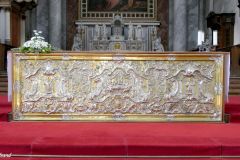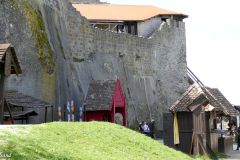This is a fine day trip out of Budapest to the scenic Danube river and three stops on the Danube Bend that are both impressive, marvellous and charming. Read up on what there is to see and how to get there.
Overview
The Danube (Donau) is the second longest river in Europe, about 2,860 km. It originates in Germany’s Schwarzwald (Black Forest) and runs east through Germany, Austria and Slovakia before turning sharply south through Hungary. It also runs through or along the borders of Croatia, Serbia, Romania, Bulgaria, Moldova and Ukraine until it finally drains in the Black Sea. The Danube passes through four capitals on its way, Vienna, Bratislava, Budapest and Belgrade.
The section in Hungary where it bends almost 90 degrees south is called the Danube Bend. This is the story of my visit to the Bend and three important landmarks. The first is the town of Esztergom with its huge Basilica. The second is the medieval fortress at Viségrad. The third is the charming small town of Szentendre. One could make this circuit in a rented vehicle or go on an organised bus tour like I did. Either way, it is likely to be a full day trip.
The drive to the town of Esztergom brings you through the northern part of Budapest, past remains of Roman baths dating from the time the Danube was the end of the civilised world. On the other side of the river was the territory of the barbarians, the ones the Roman Empire never really managed to conquer. Next, the landscape changes to flat and seemingly fertile farming land with low mountains on either side of the road.

Scenic view of farming land and mountains on the “inside” of the Danube Bend
Esztergom Basilica
Our bus went straight through Esztergom which seemed like a nice little town and crossed the Maria Valeria Bridge to Sturovo. This is Esztergom’s sister city and is actually located in Slovakia. As our guide pointed out it used to be Hungarian. On the bank of the Danube there is a place favoured among tour operators for its panoramic view of the Basilica on the other side of the river.
The Basilica is located on a hill directly above the river. The sheer size of it adds to the impression of watching a monumental church site. We went back across the river and straight up the hill. The basilica was finished in 1869 and its 100 metres height still makes it the tallest building in Hungary. The dome at the centre has a diameter of 33.5 metres. Large columns adorns the huge facade but the visitors entrance is on the side.
Inside the church the altarpiece is actually the largest painting in the world painted on a single piece of canvas. There is also a large organ, and a very large crypt (pay extra for this). This church was built on the foundation of several earlier churches, the first as early as 1001-1010.
Esztergom was the capital of Hungary from the 10th until the mid-13th century. Right outside the church there is a castle which one should have a look into. It gave name to the hill, Castle Hill. On the other side of the basilica you would want to approach the wall and admire the river view. Go right and find the large statue of King Saint Stephen – it is modern but with classical elements and an astonishing setting.
Viségrad
A short drive along the Danube Bend from Esztergom brings us to Viségrad. This is a small place known for two ancient remains. The first is the former summer palace of the King of Hungary and the other is the medieval citadel high on the mountain-side.
The palace was built in the middle ages and developed over the years. After the Ottoman invasion of Hungary it fell into ruin. Today it has been reconstructed and is open to all but me and my fellow passengers on the tour bus out of Budapest. Instead we hardly caught a glimpse of it as we were driving past. The same happened to the Lower Castle and its large hexagonal Solomon Tower further on up the road.
Our tour was destined for the Upper Castle. It was first constructed in the 1240-50s after an invasion by Mongols. It is linked to the lower castle down on the river bank, but is situated very high up on the hillside. This fortress was also conquered and damaged by the Ottomans and never again came to use. Instead it has been reconstructed and receives a large number of visitors throughout the year. I am not really complaining for the stops we didn’t make, because this citadel or fortress is certainly worth seeing. There are a series of stairs and steps leading you to the very top – with great view of the Danube river valley deep below.
Shortly after Viségrad Castle we went straight for lunch at a road-side restaurant leaving no time on our own for a walk in the streets.
Szentendre
Our third and final stop on this tour of the Danube Bend was at Szentendre. By now we had actually passed the bend and were going south towards Budapest. After Viségrad the river splits in two divided by a very long and narrow island. Szentendre lies on the right bank of the western run of the Danube. It is very close to Budapest, only around 30 minutes by train. Therefore it is very popular with Hungarian and other visitors on a half-day trip out of the capital. In fact I did that many years ago.
I remember Szentendre as a very charming little town, and it still is. However, it has grown into a mega-popular tourist trap. It is labelled an Artists’ Village. It is not. There are a number of souvenir shops selling all kinds of tourist stuff, but I failed to notice any “real” artists. Sure, there were a couple of galleries, but they drowned in the huge number of other shops and the vast number of tourists touting cameras in all directions. Like I did.
I walked outside the main artery running north-south the length of the old town, and found some nice and quiet spots. There is no doubt that Szentendre earns its reputation of being a very charming place, and I suppose it once was inhabited by artists as well. Just make sure you look up over the heads of your fellow visitors and beyond for more interesting things to see.
Practical information
Below follows a map I made showing the round-trip out of Budapest.
I booked my tour with a local company but was immediately diverted to a larger supplier of tours. If you search the web you will find several companies offering this tour, in several languages and with more or less the same itinerary. Prices do not vary much, it depends on whether lunch is included or not. In my case it was not, but I was compelled to eat at the restaurant the agency was cooperating with. I was picked up at my hotel in the morning, which is convenient.
Please note that in summer (early May through September) the tour finishes with a boat cruise from Szentendre to Budapest. I was there too early in the year so we had to return by bus.
Find more to discover in Hungary, here on Sandalsand.

































































